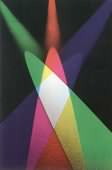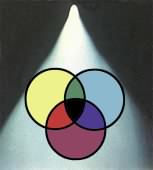The Science of Photography - Colour Reproduction
|
Chemical Image Processing | Digital Image Processing Subject Lighting | Halftone Reproduction | Mechanical Printing |
- The Source Of Colour
- Additive and Subtractive Methods of Colour Reproduction
- Recording Colours
- White Light and Colour Temperature
- More information
| The Source of Colour |
Light is the source of colour, this was first demonstrated by Isaac Newton in 1666 at the age of 23. Newton passed a ray of sunlight through a glass prism to produce a rainbow effect. He then passed these rays through a second prism to reproduce a single ray of white light. Newton thus proved that colour is in the light and that white light is a mixture of all the colours in the visible spectrum.
When light strikes a surface
the surface will absorb some colours and reflect others. It is the reflected
colours we see.
| Additive and Subtractive Methods of Colour Reproduction | Back to the top |
In 1801 Thomas Young suggested that the human eye contains three types of colour sensitive receptors. One sensitive to blue light, one to green and one to red. Varying signals from these receptors produce, in our brain, any visible colour.
In
the middle of the 19th century Clerk
Maxwell demonstrated the formation of colours by mixing red, green
and blue light. The process of adding red, green and blue light to produce
colour is called the additive system.
| The
image on the right demonstrates the additive method, where separate coloured
lights combine to form other colours.
When green red and blue light overlap the combination is white light. |
 |
Another method, called the subtractive process, was first developed independently by two talented Frenchmen, Charles Cros and Louis Ducos du Hauron in the 1860ís.
The
subtractive process uses three filters to remove unwanted colours from
white light. There are three layers, the yellow layer absorbs blue light,
the magenta layer absorbs green light and the cyan layer absorbs red light.
The subtractive process maybe
seen in the following diagram, if you move the cursor over the links different
filters will be placed over the background.
|
 |
| Recording Colours |
The first commercial photographic processes used the additive method. The Lumiere brothers patented the Autochrome process in 1904. They recorded colour by randomly covering the film plate with millions of starch grains individually dyed red, green or blue. Each grain acted as a filter and the image is broken into tiny dots of primary colours. The plate is then processed into a positive transparency. The eye has limited resolving power and is tricked into seeing a full colour image.
Such additive processes were inefficient in terms of light passing power and were difficult to print on paper or copy to another screen material, however Autochrome plates continued in production until 1932. The additive process is now used in digital cameras with filtered CCD (Charged Coupled Device) systems.
For film emulsions the subtractive process eventually superseded the additive method. However although "colour couplers", the mechanism for producing the required coloured dyes during film development, were invented in 1912 it took until the 1930ís before a practical solution to the complex technical problems were overcome.
On April 15th 1935 Eastman Kodak placed on sale the colour film called Kodachrome, largely the product of two scientists Leopold Godowsky and Leopold Mannes. Kodachrome produced a positive colour transparency and used non incorporated colour couplers. In 1936 Agfa were the first company to produce film material with colour couplers anchored within the emulsion layers.
The first negative colour film, Agfacolor, appeared in Germany in 1936. Towards the end of World War II American troops seized the Agfa plant and "liberated" the technical details of Agfacolor and the formulas were soon distributed to film manufacturers around the world. Agfacolor thus became the basis for a variety of colour processes
Now all modern colour film uses the subtractive process. Multilayer colour material is basically comprised of three permanently superimposed emulsion layers of different colour sensitivity. Usually the top one is sensitive to blue light, followed by green and red sensitive layers.
Improvements are constantly
being made and although the principles remain the same many films now contain
multiple emulsion layers of different colour sensitivity and silver halide
crystal structure. The aim being to improve both film speed and colour
reproduction.
| White Light and Colour Temperature | Back to the top |
We recognise a mixture of visible light at different wavelengths as being "white" light. Although the distribution of energy at each wavelength could vary considerably from source to source our brains still perceive it as "white" light.
Move your cursor over the links below to see changes in the composition of white light depending upon the source, the chart shows wavelength against relative power.
 |
|
Photographic processes, both digital and chemical, record subtle differences in colour. For photographic purposes a common method of gauging the balance of colours of an artificial light source is by "Colour Temperature". As an incandescent light heats up, not only does the temperature vary but so does the colour.
|
 |
The colour temperature chart
above indicates the approximate colour temperature of various "white" light
sources in degrees Kelvin.
| More Information | Back to the top |
For more information about colour reproduction please refer to the following sections :
- Creating reversal images from slide film
- Creating prints from colour negatives
- Colour Recording using a Digital Image Sensor
- Printing a digital image
- Halftone colour reproduction
Next in the Science of Photography
:
Chemical
Image Processing
Forming
the Image | Controlling
the Image | Colour
Reproduction
Chemical
Image Processing | Digital
Image Processing
Subject
Lighting | Halftone
Reproduction | Mechanical
Printing
